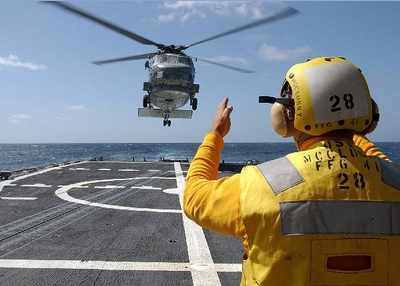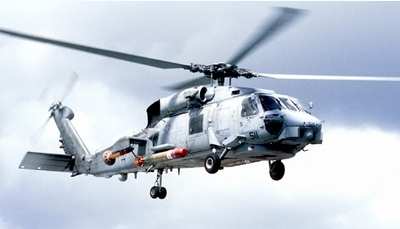 The Naval Air Systems Command (NAVAIR) air vehicle
engineering department has cleared the in-service U.S. Navy Seahawk
fleet of H-60B/F/Hs to continue flying to 12,000 hours. This
milestone marks a major achievement for the numerous Seahawks
currently supporting Operations Enduring Freedom and Iraqi Freedom,
as well as a variety of Counter Drug and Homeland Security
Operations.
The Naval Air Systems Command (NAVAIR) air vehicle
engineering department has cleared the in-service U.S. Navy Seahawk
fleet of H-60B/F/Hs to continue flying to 12,000 hours. This
milestone marks a major achievement for the numerous Seahawks
currently supporting Operations Enduring Freedom and Iraqi Freedom,
as well as a variety of Counter Drug and Homeland Security
Operations.
The requirement for at least a 12,000-hour airframe life was
recognized in mid-2001 when facing two major inventory changes.
First, the MH-60R multimission helicopter was changing from a
remanufacture strategy to a new build strategy. The increased time
for new build would mean MH-60Rs would take more time to fully
field to the fleet when it commenced deliveries in 2005.
Second, the Chief of Naval Operations was to approve a new
Helicopter Concept of Operations transition plan (approved January
2002). This major warfighting and transition strategy made the
MH-60R/S the primary maritime helicopters for the entire Navy.

The single biggest consequence of these two changes was the
formation of a gap in usable SH-60B Seahawk aircraft during the
transition. There was only one possible solution that did not
jeopardize either program - the service life of the Navy’s
SH-60B had to be extended from the current life limit of 10,000
hours through an advanced service life extension (ASLE) program to
12,000 hours. The extension for the SH-60F and HH-60Hs would allow
for flexibility to mitigate future inventory problems.
ASLE is not a new concept within the NAVAIR helicopter
engineering community. Chuck Miller, an engineer with
NAVAIR’s air vehicle, structures - strength engineering
department, and Mike Bumgarner, NAVAIR Cherry Point, N.C., H-60
in-service support team, were given the task to develop a way
forward to 12,000 hours that could be adapted to any further life
increase requirements.
Both engineers’ teams worked closely with each other,
using their respective talents and experience to develop a solid
plan and schedule forward to meet the goal. The process targeted
aircraft between 9,500 and 10,000 hours.
Through the type commander, the squadron and type wing would
submit a request for inspection. The closest depot would then
evaluate and document the material condition of the aircraft with
specific inspections related to structural fatigue. This data was
forwarded to the in-service support team at Cherry Point to review
and determine corrective actions for discrepancies, as well as
documenting satisfactory material condition to justify extension.
These findings were then reported to the strength engineering
department for review and to determine any structural fatigue
trends.

After 12 aircraft were inspected and found to meet the
requirements set forth by Miller, a blanket extension would be
granted for the entire fleet. In April 2003, the strength
engineering department released the blanket 12,000-hour service
life extension message completing an effort that started in June
2001.
“This effort was expeditiously completed during a time of
high national tasking for the H-60 fleet, as well as the
engineering and logistics support structure for those
aircraft,” said Ken Caniglia, deputy program manager for
NAVAIR’s H-60 program office. “Those considerations
being accounted for, the achievements of the H-60 team at NAVAIR,
the depots, and the fleet are even more impressive. Battle group
commanders will continue to have adequate numbers of H-60 aircraft
filling critical mission tasks, and the path forward to helicopter
CONOPS (concept of operations) is closer to being a reality.”
[ANN Thanks Renee Hatcher, NAVAIR Public Affairs]
 ANN's Daily Aero-Linx (04.16.24)
ANN's Daily Aero-Linx (04.16.24) Aero-News: Quote of the Day (04.16.24)
Aero-News: Quote of the Day (04.16.24) Airborne 04.10.24: SnF24!, A50 Heritage Reveal, HeliCycle!, Montaer MC-01
Airborne 04.10.24: SnF24!, A50 Heritage Reveal, HeliCycle!, Montaer MC-01 Airborne 04.12.24: SnF24!, G100UL Is Here, Holy Micro, Plane Tags
Airborne 04.12.24: SnF24!, G100UL Is Here, Holy Micro, Plane Tags Airborne-Flight Training 04.17.24: Feds Need Controllers, Spirit Delay, Redbird
Airborne-Flight Training 04.17.24: Feds Need Controllers, Spirit Delay, Redbird





